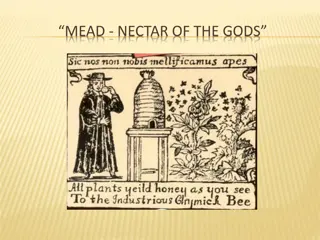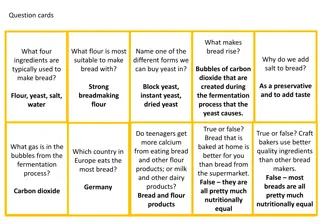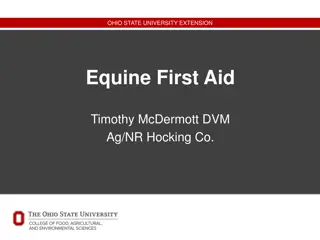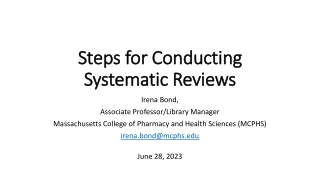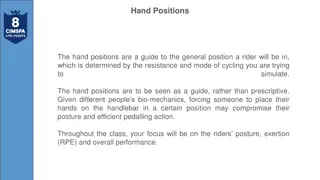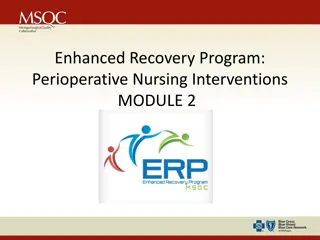The Essentials of Making Mead: A Beginner's Guide
Learn the basics of mead making, including the different types of mead, simple ingredients and methods, fermentation process, and practical tips on cleaning, honey selection, and water quality. Explore the world of mead with insights from an expert speaker from Michigan State University.
Download Presentation

Please find below an Image/Link to download the presentation.
The content on the website is provided AS IS for your information and personal use only. It may not be sold, licensed, or shared on other websites without obtaining consent from the author. Download presentation by click this link. If you encounter any issues during the download, it is possible that the publisher has removed the file from their server.
E N D
Presentation Transcript
How to Make Mead THE ESSENTIALS OF MEAD MAKING Our guest speaker David Voss - Michigan State University
Basic Kinds of Mead Still meads are not carbonated Sparkling meads are carbonated with CO2 generated during secondary fermentation, often in the bottle. Melomels contain fruit (Other than apples or grapes) Pyment contains grapes or grape juice Cyser (also spelled cyzer) contains apple cider Metheglins contain herbs/spices
Mead Making at its Simplest Ingredients Honey 3-5 pounds, per gallon of mixture Yeast (originally what was around randomly, later added deliberately) Water Method Bring water to a simmer (175-180 F) Add honey slowly mix thoroughly until homogenous. Skim off any floating insolubles. This solution is called the must Cool to well below 170 F, add yeast Close system with bubbler, yeast should start producing CO2 in 24 hours
Whats Going On In The Fermenter 1. The yeast reproduce as long as there is oxygen present (since the system is closed there is a finite supply) 2. When the yeast use up the available oxygen they stop reproducing and start fermenting the available sugar(s) to ethanol and CO2 3. When all of the sugar is consumed or when so much ethanol has been produced that the particular strain of yeast cannot tolerate more, fermentation ceases
Practical Considerations I Cleaning and Sanitizing Cleaning is removing the gross impurities from items with soap/detergents and hot water Sanitizing is treating tools & containers with dilute bleach to completely sterilize surfaces, so that the only microorganisms that will be present is the deliberately added yeast.
Practical Considerations II Honey This is normally of the greatest concern to the mead maker. What is the pollen source, is it source monolithic or varied? Since you are the apiarist, you have much more knowledge here than most other people trying their hand at mead. If you are first trying a simple mead, the most reproducible results will be with whatever is your most consistent honey.
Practical Considerations III Water Spring water is often considered ideal as it has sufficient minerals to help grow the yeast, but not too many that may impart bad flavors, or in some cases poison the yeast. Distilled or RO water will not work well unless you deliberately add minerals (these are sold at brewing supply shops) If you do not have a good source of spring water, obtaining distilled water and adding the appropriate minerals may be the best way to get consistent results.
Practical Considerations IV Yeast There are almost innumerable strains of yeast To start, use a strain that is recommended for the type of mead you want to make Some yeast manufacturers recommend and sell nutrient packets (minerals and micronutrients combined) for their yeasts. They re a good idea if you are going to use those yeasts
How Long Does This Take? There is no one good answer. Depending on the temperature where primary fermentation is taking place (75-80 F would be ideal) 6 weeks to 6 months is reasonable. The room itself (glass containers can be covered with aluminum foil) should be mostly dark and relatively undisturbed.
Reproducibility If you make a mead you like the chances of doing it again are directly proportionally to how much information you recorded as you were making it (and how thoroughly you sterilized everything) At the least take a specific gravity of the starting must and periodically as it ferments. pH and refractive index are also very useful, but involve more expensive apparatus .
Racking the Mead When primary fermentation has ceased (CO2 evolution has definitely stopped) it is time to rack the mead (separate the liquid from the lees) This can be done via siphon, simple drainage using a tank with a spigot or using a filter. Once in the new container (should be the same size as the original) it is fitted with an airlock so secondary fermentation can begin (fruit or more honey can also be added at this point) Multiple rackings may be necessary. When you are satisfied with the flavor it is done and time to bottle.
Bottling the Mead Bottles can be as simple a used wine bottles (cleaned obviously) with new corks, screw-cap bottles, bottle- cap top bottles (requires a bottle capper) or Grolsch bottles (expensive at first but completely reusable) If you know or suspect further fermentation may occur in the bottle, be sure to use pressure resistant bottles.
A Traditional Mead Recipe from MeadMaking.net 12 lbs unprocessed honey, 5 gallons spring water, 2 packets dry yeast, 2 tsp yeast nutrient. Heat 2 gallons of spring water to 160 F in a large kettle and remove from heat. Add yeast nutrient and 12 lbs unprocessed honey, and then stir until thoroughly dissolved. Transfer kettle back to heat and bring back to 160 F; maintain this temperature for 30 minutes. Skim off any foam that accumulates. Remove from heat and let cool; add 1 to 2 gallons spring water to quickly bring the temperature back down below 90 F. Transfer the must to primary fermentation chamber and aerate by shaking or stirring for 5 minutes. Start yeast per packet instructions before pitching into must. Add fermentation lock and store in a cool dark place for 14 to 28 days. When you see one bubble every sixty seconds, primary fermentation has concluded. Rack the mead into the secondary fermentation chamber and store in a cool dark place for 2 to 4 months. Sample the mead and bottle once it has achieved an acceptable level of clarity and shows no further signs of fermentation.
A Complex Metheglin Royal Metheglin by BYO.com 1 Gallon Ingredients 3 lbs. (1.4 kg) honey 3 tsp. (15 g) fresh rosemary leaves 3 tsp. (15 g) fresh thyme leaves 3 tsp. (15 g) orange zest 3 tsp. (15 g) lemon zest 3 fresh sage leaves 3 bay leaves 1 tsp. (5 g) dried hyssop 4 allspice berries 6 cloves 3 tsp. (15 g) fresh ginger, chopped 2 bags Earl Grey tea 1 tsp. (5 g) pectic enzyme 1 tsp. (5 g) acid blend 1-1/2 cups (360 mL) orange juice 1 package Montrachet yeast (5 to 7 g)1 tsp. (5 g) yeast nutrient 1/4 tsp. (about 1 g) grape tannin 1 campden tablet Step by Step Boil the honey in water (1 part honey to 2 parts water) in a large non- reactive pot for 10 to 20 minutes, skimming off the foam. When the foam stops rising, add herbs and spices. Cool and transfer to a two-gallon plastic container. Brew the tea by steeping in a cup of boiling water for 5 minutes. Add the tea to the honey mixture along with the acid, the pectic enzyme and water to make a gallon. Add the campden tablet and let the mixture sit, well-covered, for 24 hours. Make a yeast starter by combining the yeast and yeast nutrient with tepid orange juice. Cover, shake vigorously, let stand until bubbly (1 to 3 hours), then add to the must. Add tannin and allow the mixture to ferment. Rack after the most vigorous fermentation and siphon the wine into a one-gallon, airlocked fermenter. Rack into another airlocked fermenter in 3 months and again in 6 months. Rack again before bottling, about one year after fermentation started. Bottle and cork. Store in a cool cellar for 6 months before using.
Our guest speaker David Voss - Michigan State University https://www.linkedin.com david-voss-90461213 David Voss. Teaching Laboratory Manager at Michigan State Dave Voss is 57, and has been at MSU since he started working on his Masters Degree in 1987. Got that in 1990 but never left the university (or them department). Started making mead with friends about 1997. Have done dozens of different varieties, from straight meads to cysers, floral, and heavier fruits; using both beer and wine yeasts depending on what we were trying to make. Topic: Making Mead Married to Lisa Sanders-Voss Since June 13, 1988 voss@chemistry.msu.edu


